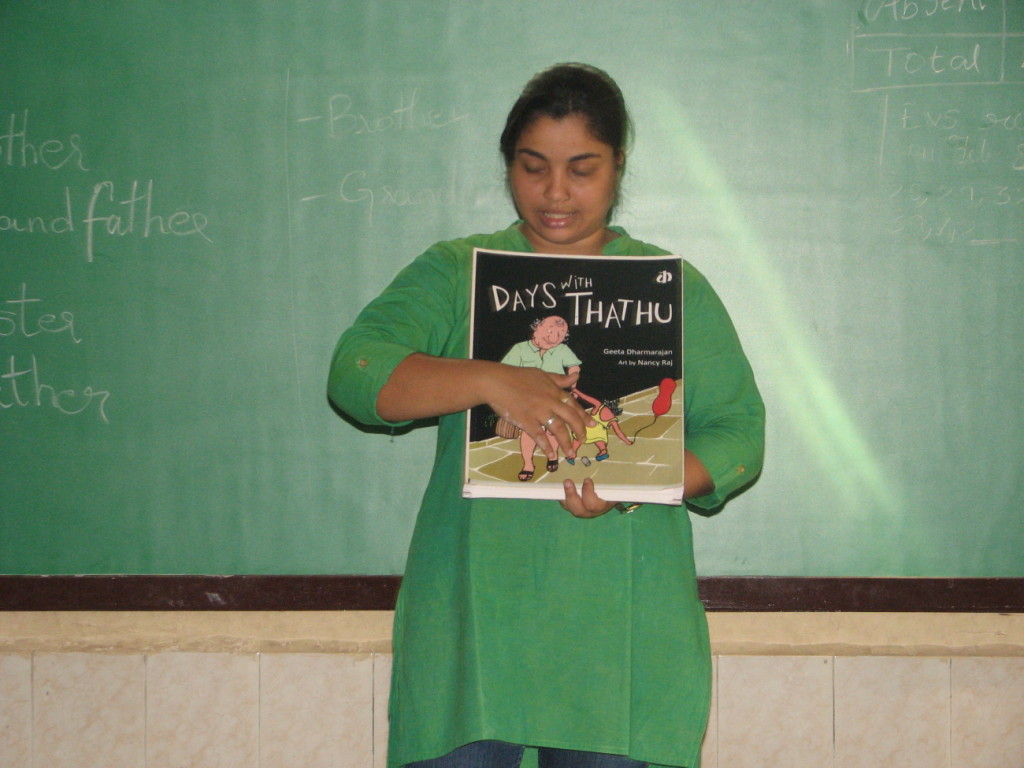Friday. St. Thomas Girls Primary School, Aldona.
It’s a writing week in LiS schools. This means that our focus for the extension activity is to facilitate the kids to produce text on their own.
For this particular class in Std. 3, I have (for some unapparent reason) chosen to do Days with Thathu. This is a beautiful book with captivating illustrations in which a little girl gives us glimpses of the ordinary, mundane things she does with her grandfather, that become extra-ordinary by sheer virtue of the fact that they do these things together.
I think that it is a beautiful book that has the capacity to draw an “Awwwww” and somehow make you feel ‘warm and fuzzy’ inside. I found that it moved me. To throw some light on why I said ‘for some unapparent reason’ only a few lines earlier- While I like this books very much at a personal level, it is not my regular choice of book to do in a classroom or at MOP. This, simply because I worry about having to react to a child saying that they have no Grandfather or a child having recently lost a Grandparent or in general, stirring up some sudden flurry of emotion. So before this day, I have generally avoided doing this book. I did not want to be caught unaware or surprised.
As luck would have it, both those things happened in class that day.
Once we were in the zone of families and grandparents and things we do with our grandparents, it was time for me to bring out the book. ‘Written by Geeta Dharmarajan and illustrated by Nancy Raj’…. I started off. I paused for a second to ask if we had read any other story about a young girl and her grandfather (having done the Village Fair myself in this class not more than a couple of weeks ago). And I got the response that I was looking for with no fuss.
Now came the moment that would prove to surprise me. A girl on the second bench raised her hand to say something. She stood and very confidently told me that Nancy Raj had illustrated the Village Fair as well. *struck by lightning* It didn’t end there. She pointed out that Malli; which Priya Naik had read to them a while ago; had, yet again, been illustrated by Nancy Raj.
It is said that lightning never strikes the same place twice. At that moment, I could heartily have testified against this so called fact. I was struck by this observation made by a third grader.
3 different books. Yes, done by the same illustrator; but each displaying a unique illustrative style of it’s own. The fact that these 3 books have been illustrated by the same person is information I’ve looked at and read out many times; it sits at the back of my mind. The fact that this child, in a school we have worked with for the shortest amount of time this academic year, was able to point it out was and remains to me a remarkable phenomenon.
And only after this did our story begin. Throughout the reading, the girls were gripped, by the pictures and the story. They laughed. Smiled. Some were serious. Some had blank expressions. All paid attention. At the end, they clapped (yet another unusual phenomenon). And one girl said, ‘So nice, Teacher! She and her grandfather did such nice things!’
As we launched into the post-story discussion, it’s apparent that most of the kids had had some reaction to the story book. And they spoke about it. They gave me glimpses into their worlds, the things they like to do with their grandpas. Things their grandfather/parents did for them. Things they used to do. Things they remembered.
And this moment, the feeling, the thoughts, the memories. This is precisely I requested them to transfer to paper. “What do you like to do with your grandfather or what are the things the girl in the book liked to do with her Grandfather? Write and if you can, draw a picture.” I instructed. And they were engaged. They began in earnest to write. I spotted one girl staring blankly into space, paper as yet untouched by the pencil; sacrilege in a LiS class, time constraint taken into consideration! I rushed over to her and asked her what she was doing or more appropriately, why she was doing nothing. She responded simply that her Grandfather was not here and she had no memory of him. My own fear was brought to the fore. She proceeded to tell me that she spent more time with her father, could she write about him? I told her that it was nice that she wanted to write about her father, but for connect with the book read aloud, could she write about the girl in the book? The response appeased her.
It has been said that every heart has a story to tell. These stories may or may not always always be easy to tell. But here in lies the power of a good story. It leads us to think, it leads us to feel, it allows us to express. And that is what happened that day.




